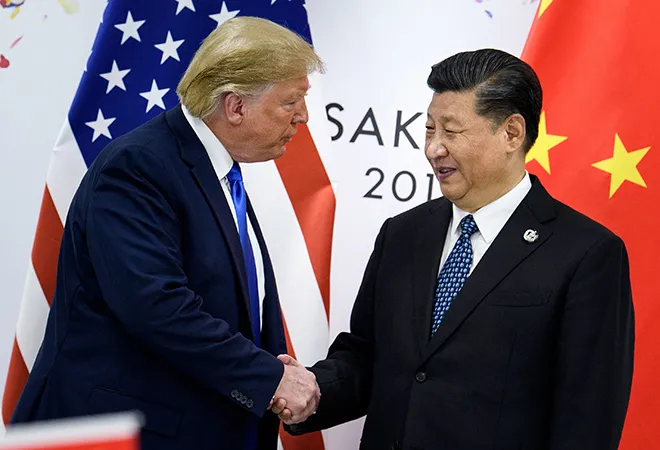-
CENTRES
Progammes & Centres
Location
The ‘great divide’ between Washington and Beijing that had simmered for many years before Trump came to office, has crystallised into open hostility.

The most disruptive event in the last four years of the Trump presidency has been his administration’s trade war with the People’s Republic of China (PRC), with Trump pushing back against what it calls China’s predatory trade practices and intellectual property theft. The ‘great divide’ between Washington and Beijing that had simmered for many years before Trump came to office, has crystallised into open hostility. The imposition of tariffs and counter-tariffs has been the most visible element of Trump’s trade war against the PRC. Trump ramped up pressure against China by raising tariffs on a wide range of products, including machinery and motorcycles. Under Trump, the US has emphatically called out China’s predatory trade practices which has involved the grant of heavy subsidies to key sectors, thereby preventing foreign companies and investors from penetrating and competing in the Chinese market.
To be sure, the US’ trade deficit vis-à-vis China has been a source of consternation for successive American administrations dating back to at least the mid-1980s. Yet, none of them succeeded in forcing the PRC to commit to a trade deal with Washington that addresses American concerns. The Trump administration itself is yet to secure a deal that involves China buying more American goods. What it has achieved is that it has compelled the PRC to commit provisionally in January 2020 to reduce the deficit by approximately US$ 200 billion.
The US’ other key concern is the PRC’s continuing theft of its Intellectual Property (IP). It is estimated that the US economy loses some US$ 600 billion annually due to the PRC’s pilferage, ranging from technical know-how through cyber means, to purloining movies. Liabilities for US companies investing in the PRC increased largely on account of China’s mandating that they divest business secrets that are proprietary and involve significant investment to develop.
The second disruptive aspect of the Trump presidency is related to the US’ relations on the PRC’s periphery, particularly the Korean Peninsula. Regardless of the setbacks, the Trump administration’s decision to engage Pyongyang in direct talks was undoubtedly disruptive to the extent that it caught Beijing off-guard, as well as Washington’s ally – the Republic of Korea (RoK) or South Korea.
The Trump administration’s national security strategy in the context of the Indo-Pacific has brought strategic competition back to the region to contest Chinese revisionism and aggression. The US introduced the principle of ‘Free and Open Indo-Pacific’ (FOIP), making it a central tenet that will directly counter China’s quest for hegemony in the region.
Finally, the Trump administration’s national security strategy in the context of the Indo-Pacific has brought strategic competition back to the region to contest Chinese revisionism and aggression. The US introduced the principle of ‘Free and Open Indo-Pacific’ (FOIP), making it a central tenet that will directly counter China’s quest for hegemony in the region. Under Trump, the Indo-Pacific region has witnessed a more skillful embrace of three states—i.e., Japan, India and Australia—as part of the Quadrilateral Security Dialogue (or the Quad). There has also been a more robust engagement with Taiwan, and a significant expansion in Freedom of Navigation Operations (FONOPs) in the South China Sea (SCS) and the East China Sea (ECS).
Overall, President Trump has shaken up the landscape in the Indo-Pacific unlike any one of his predecessors by reviving competition and making it the core element of US strategy. If he fails to win a second term, his successor cannot ignore the changes that he has wrought; sustaining the momentum in the region will be an imperative.
The views expressed above belong to the author(s). ORF research and analyses now available on Telegram! Click here to access our curated content — blogs, longforms and interviews.

Kartik Bommakanti is a Senior Fellow with the Strategic Studies Programme. Kartik specialises in space military issues and his research is primarily centred on the ...
Read More +